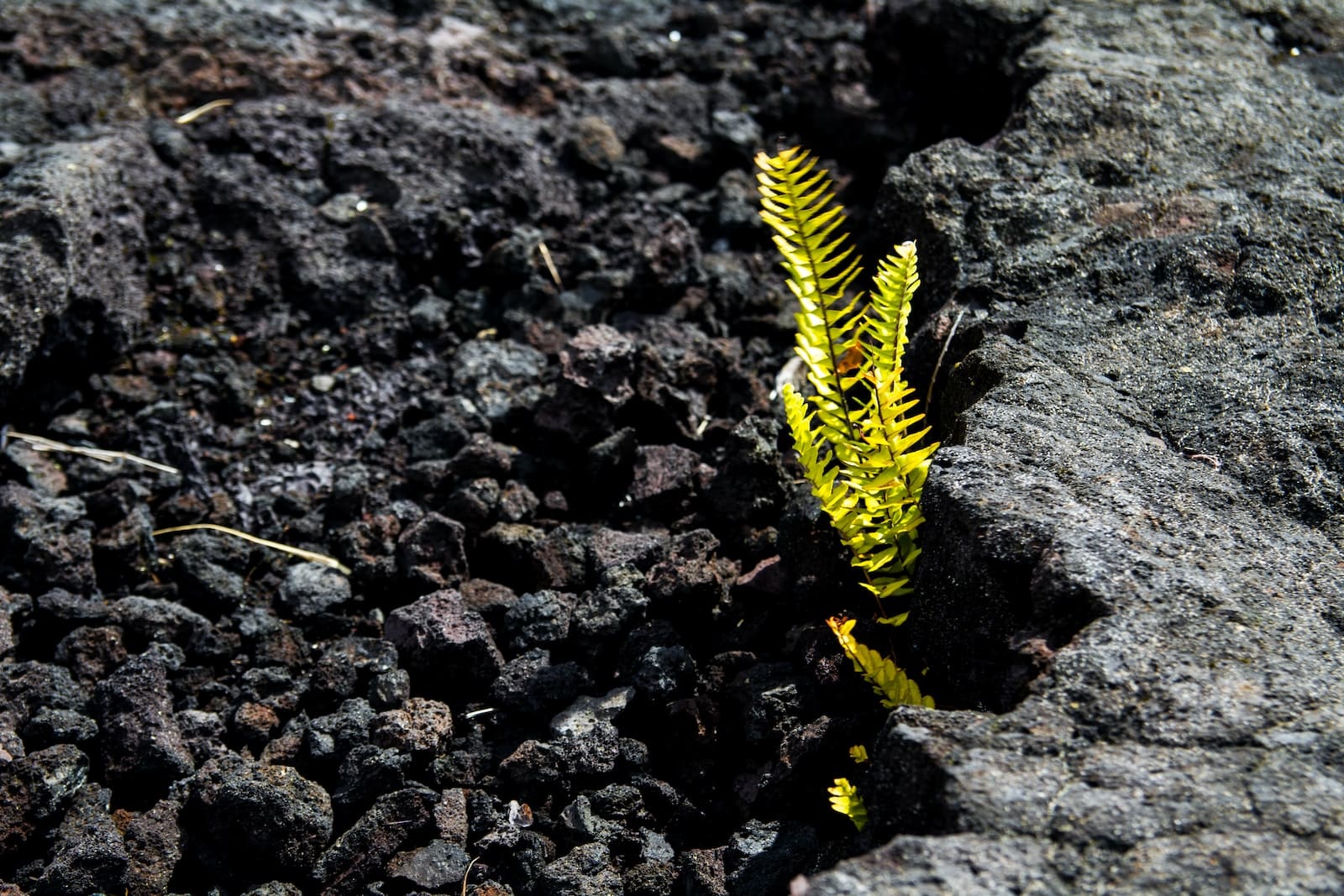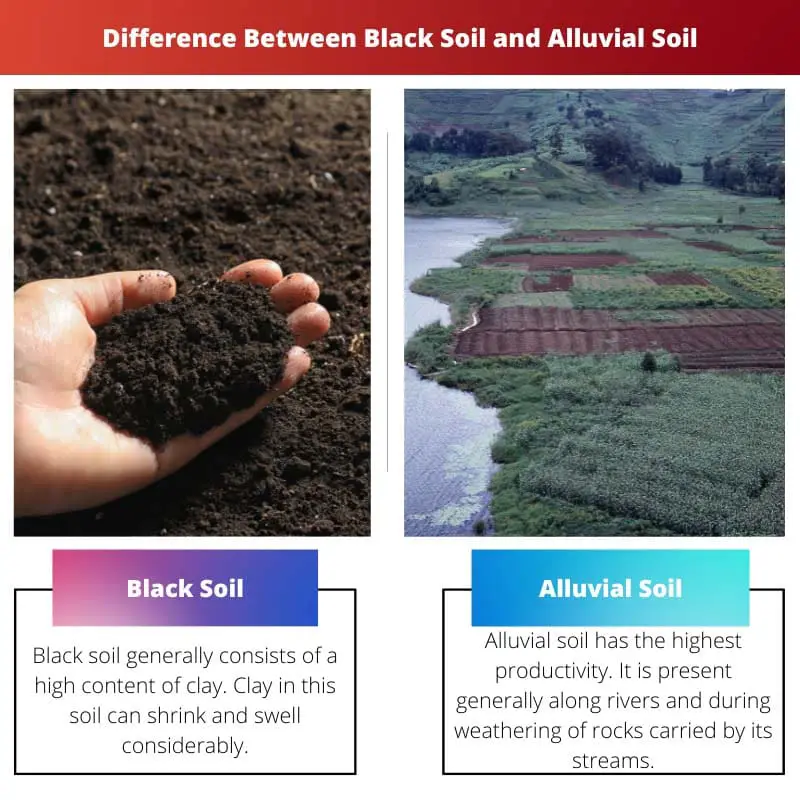When it comes to soil, the surface material is loose and covers most land. It offers the plant structural support used in agriculture and is their source of nutrients and water.
Processes like leaching, microbial activity, and weathering combine to make a layer of distinctive soil types.
There are different types of soil like red soil, forests and mountain soil, alluvial soil, desert soil, black soil, saline and alkaline soil, laterite and lateritic soil, and peaty and marshy soil. Each type has particular weaknesses and specifications.
In this article, the chief focus is on differentiating black soil and alluvial soil.
Key Takeaways
- Black soil contains higher levels of clay, iron, and aluminum than alluvial soil, making it better suited for water retention.
- Alluvial soil originates from river deposits, resulting in rich, fertile soil ideal for agricultural use.
- Black soil forms in volcanic regions and exhibits a self-plowing property due to its unique structure.
Black Soil and Alluvial Soil
Black soil is a very fertile mineral containing a high percentage of humus, phosphorus, and ammonia compounds. It has a black surface horizon and is formed due to weathering of igneous rocks and lava flows. The deposition of rivers forms alluvial soil. It is rich in minerals and nutrients.

Black soil consists of a high content of clay. Clay in this soil can shrink and swell considerably.
This is the reason black soil on drying leads to deep cracks. Even with less irrigation, the crops can be grown.
It has high buffering and holds nutrients comparatively for a more extensive duration and amount.
Concerning other soils, alluvial soil has the highest productivity. It is present along rivers and during weathering of rocks carried by its streams.
It has very soft strata with the humus in nitrogen’s lowest proportion with phosphate and an adequate amount.
Comparison Table
| Parameters of Comparison | Black Soil | Alluvial Soil |
|---|---|---|
| Also called | Black cotton soil or regur soil | Riverine soil |
| Fertility | Low fertile (uplands) Very fertile(valleys) | Highly fertile |
| Texture | Highly argillaceous | Both clayey and sandy |
| Formation | By weathering of igneous rocks as well as lava flow | By deposition of river |
| Color | Black | Colour |
What is Black Soil?
Black soil is trapped lava’s derivatives, and art spread mainly across interior Karnataka, Gujarat, Madhya Pradesh, and Maharashtra on the Malwa and Deccan lava plateau especially where there is basaltic rock as well as moderate rainfall.
Black soil’s iron-rich granular structure makes it resistant to water and wind erosion. It is also found on many peripheral tracts where basalts underlying have been shifted from their original location through the fluvial process.
The shifting has led to clastic content’s increased concentration.
For most of the black soil, the parent material is volcanic rocks. In the rainy season, strenuous effort is required for working on such ground as it gets very sticky due to a small proportion of iron or titaniferous magnetite, and the parent’s rock black constituents make it black.
For centuries, black soil has been used to grow crop varieties without adding manures or fertilization, with little or no evidence of exhaustion. When it comes to sugarcane and rice, they both are equally important where irrigation facilities are available.

What is Alluvial Soil?
Alluvial soil is soil which, by surface water, gets deposited. They can be found along rivers, stream terraces, alluvial fans, deltas and floodplains.
It offers many functions, but the greatest is serving as the kidneys of earth. It removes nutrients and sediment flowing in the adjacent water.
Alluvial soil also helps remove contaminants from rivers, and for downstream communities, it improves water quality because floods periodically at the surface deposit new sediment and alluvial soil can look uniquely layered.
Due to an alluvial soil’s recent origin, it has an immature and weak profile. Alluvial soil is mostly sand, and it is uncommon to find in the form of clayey soil.
Along the river terraces, the calcareous concretions and kankar beds are present in some regions.
Due to recurrent floods, alluvial soils are constantly replenished. Texture and porosity offer good drainage as well as other conditions for agriculture which are favourable.
Geologically, the great plain of India’s alluvial soil is classified into older Bhangar soils and younger or newer Khadar.

Main Differences Black Soil and Alluvial Soil
- The chemical composition of black soil is phosphates, hummus and nitrogen (low), potash (less than 0.5 per cent), iron oxide (9-10 per cent), alumina (10 per cent), magnesium carbonates, and lime (6- 8 per cent). Meanwhile, chemical properties of alluvial soil are nitrogen (low), potash, phosphoric acid and Alkalies (adequate), lime, and iron oxide (vary within a wide range).
- Black soil mostly consists of the Deccan trap region, consisting of parts of Gujarat, Maharashtra, Tamil Nadu, Madhya Pradesh, and Andhra Pradesh. In contrast, the alluvial soils are widespread in the river valleys and the northern plains. The peninsula region is found in East Coast’s deltas and the River Valleys.
- When it comes to the capacity of moisture retention, there is a higher moisture retention capacity of black soil. On the other hand, alluvial soil also has a capacity for moisture retention but less than black soil.
- In terms of coverage area, black soil covers about 16.6 per cent of the total area, which is equal to 46 lakh sq km. On the flip side, alluvial soil covers about 46 per cent of the total area, and that’s why it is the largest soil group covering.
- For the cotton crop, black soil is best suited. The other major black soil crops consist of castor, wheat, linseed, sunflower, Virginia tobacco, and millets. Conversely, alluvial soil is best suited for sugarcane, rice, cotton, maize, wheat, tobacco, jute, and oilseeds.

References
- https://www.sciencedirect.com/science/article/pii/S1002016007600034
- https://www.sciencedirect.com/science/article/pii/S0167198799000914
